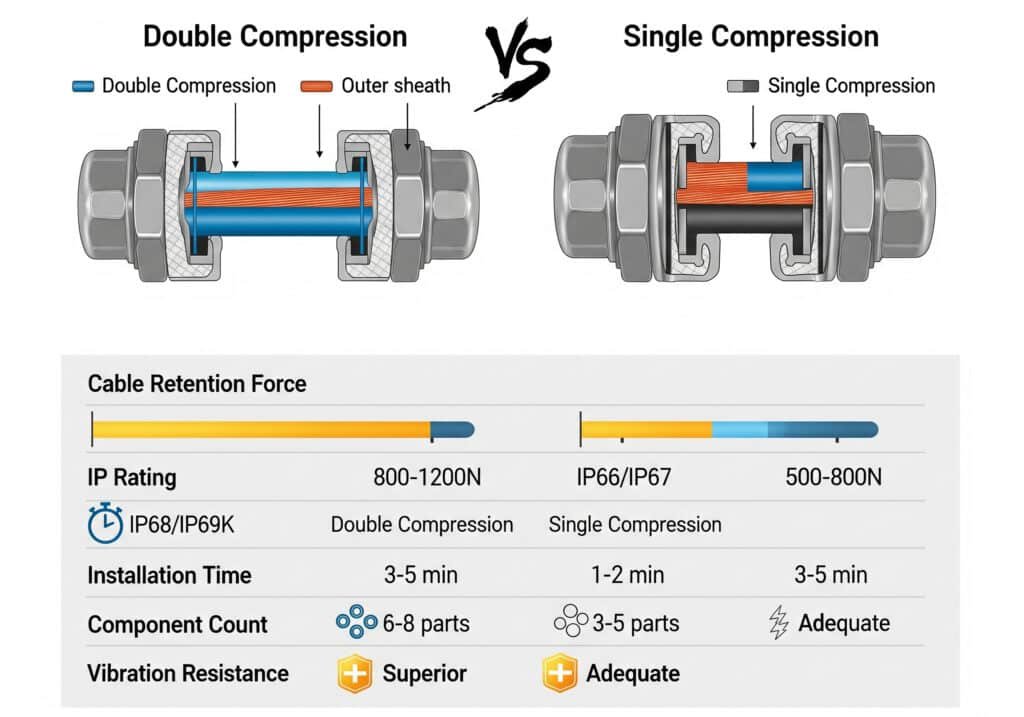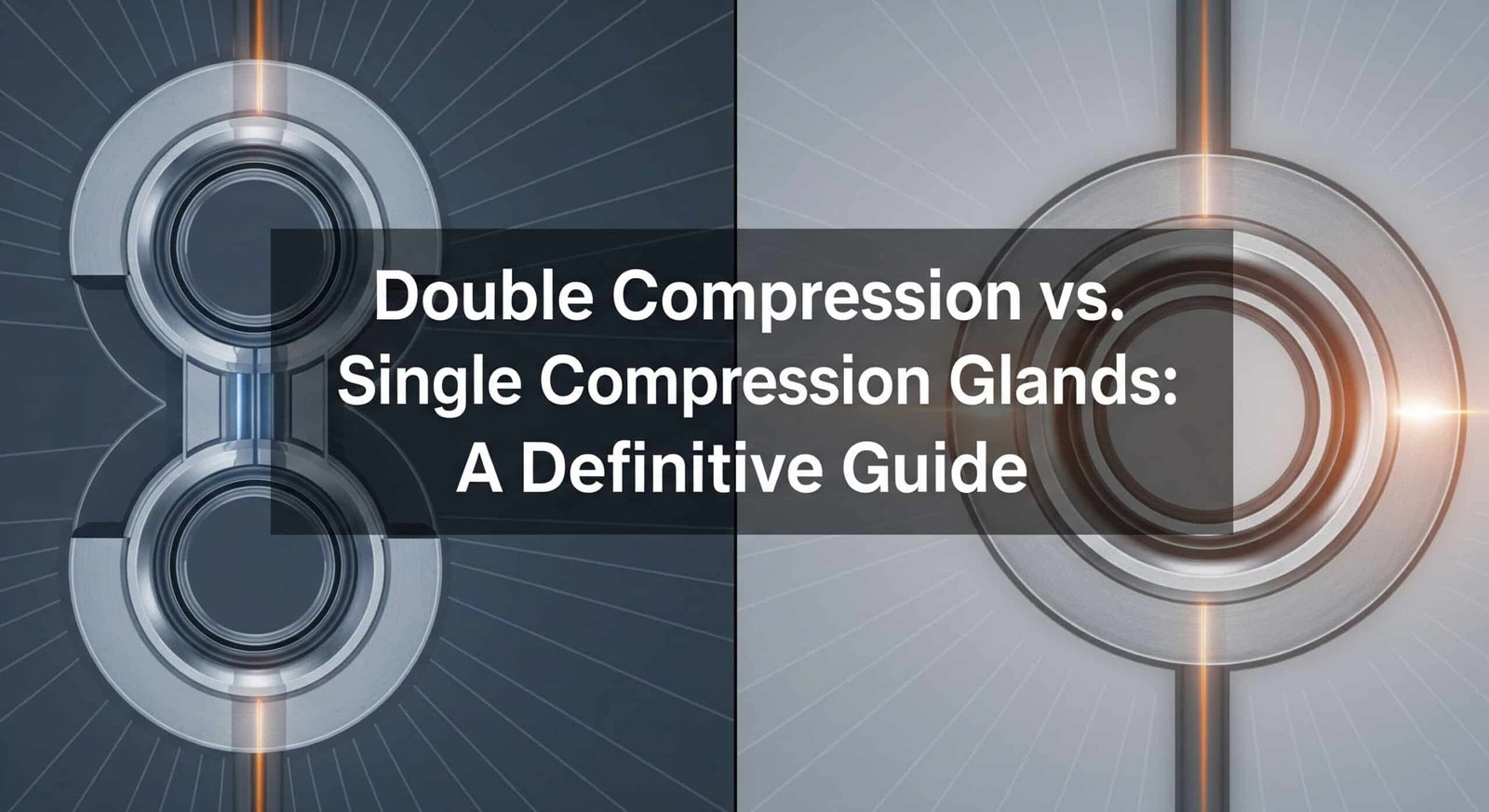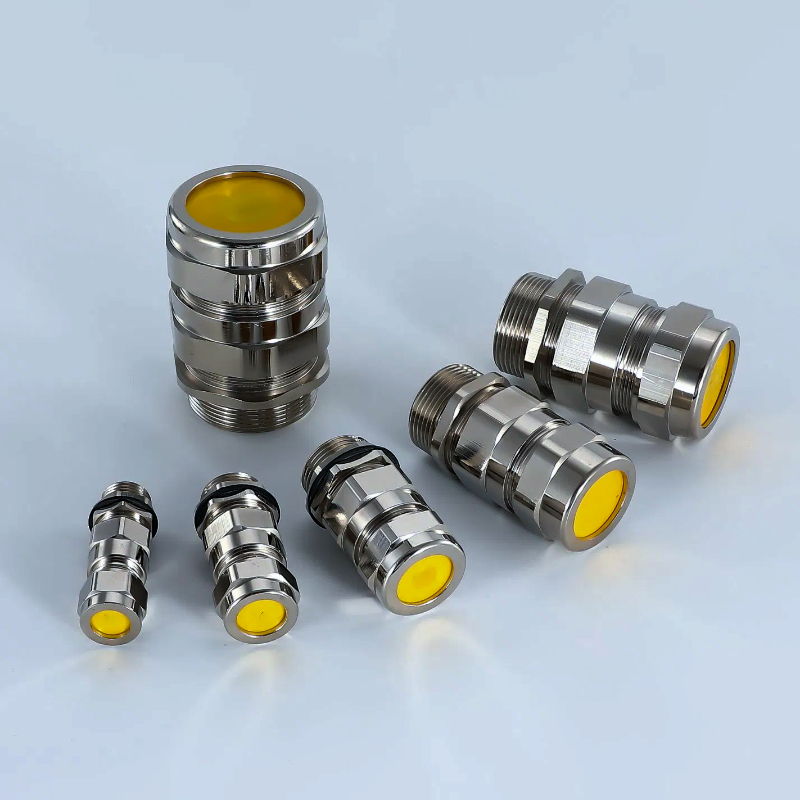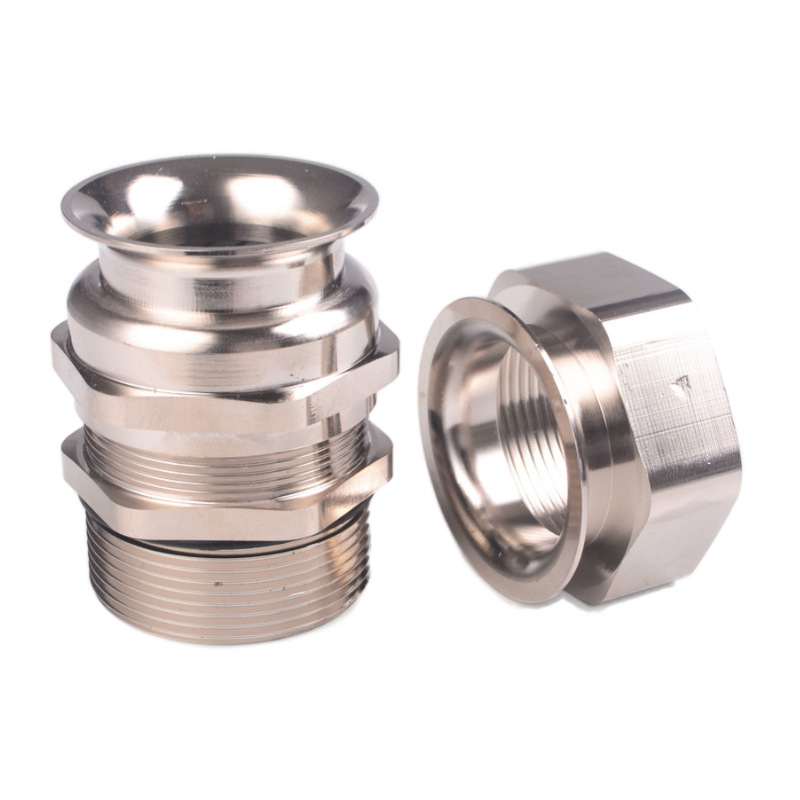Introduction
Are you struggling to choose between double compression and single compression cable glands for your next project? This decision could mean the difference between a reliable, long-lasting installation and costly maintenance headaches down the road. The wrong choice might lead to cable damage, moisture ingress, or even complete system failure in critical applications.
Double compression cable glands provide superior cable retention and sealing through two separate compression zones, while single compression glands offer a simpler, more cost-effective solution with adequate performance for standard applications. The key difference lies in their compression mechanism design and resulting performance characteristics.
As Sales Director at Bepto Connector, I’ve helped countless engineers and procurement managers navigate this exact dilemma. Just last month, David from a major automotive manufacturer in Detroit was facing pressure to reduce costs while maintaining quality standards for their new production line. His story, along with insights from our 10+ years in the cable gland industry, will help you make the right choice for your specific needs.
Table of Contents
- What Are Double Compression Cable Glands?
- What Are Single Compression Cable Glands?
- How Do Double vs Single Compression Mechanisms Work?
- When Should You Choose Double Compression Over Single?
- Cost Analysis: Double vs Single Compression Value
- FAQs About Compression Cable Glands
What Are Double Compression Cable Glands?
Double compression cable glands feature two distinct compression zones that independently secure the cable jacket and provide enhanced sealing performance. This dual-zone design offers superior cable retention force and improved environmental protection compared to traditional single compression systems.
Key Design Features
The double compression mechanism consists of two separate compression elements:
Primary Compression Zone: Located at the cable entry point, this zone grips the outer cable jacket using a specialized compression ring or cone. This primary grip prevents cable pullout and provides the main mechanical retention force.
Secondary Compression Zone: Positioned deeper within the gland body, this zone creates an additional seal around the cable using a secondary compression element, typically an O-ring or elastomeric seal. This dual-layer approach significantly enhances IP rating1 performance.
At Bepto, our double compression cable glands achieve IP68 ratings consistently, even under extreme temperature variations from -40°C to +100°C. We’ve tested these extensively in our ISO9001-certified2 facility using both our internal CNC equipment and third-party validation through TUV certification processes.
Applications and Industries
Double compression glands excel in demanding environments where cable security and environmental protection are critical:
- Marine and offshore installations where saltwater exposure demands superior corrosion resistance
- Industrial automation systems requiring vibration resistance and long-term reliability
- Renewable energy projects like solar farms and wind turbines facing extreme weather conditions
- Chemical processing facilities where aggressive chemicals could compromise single-seal systems
Hassan, who manages a petrochemical facility in Abu Dhabi, recently shared his experience: “After switching to Bepto’s double compression stainless steel glands, we’ve eliminated cable replacement cycles that were costing us $50,000 annually. The dual compression zones handle our harsh chemical environment perfectly.”
What Are Single Compression Cable Glands?
Single compression cable glands use one compression mechanism to simultaneously provide cable retention and environmental sealing through a unified compression action. This streamlined design offers simplicity, cost-effectiveness, and reliable performance for standard industrial applications.
Design Characteristics
Single compression systems integrate cable gripping and sealing functions into one compression action:
Unified Compression Element: A single compression ring, cone, or elastomeric insert provides both mechanical cable retention and environmental sealing. When tightened, this element compresses radially around the cable, creating both grip force and seal integrity simultaneously.
Simplified Construction: Fewer components mean reduced manufacturing complexity, lower material costs, and simplified installation procedures. This design philosophy makes single compression glands ideal for high-volume applications where cost optimization is essential.
Performance Capabilities
Despite their simpler design, quality single compression glands deliver impressive performance metrics:
- IP ratings up to IP66/IP67 for most standard applications
- Temperature ranges from -20°C to +80°C covering typical industrial environments
- Pull-out forces exceeding 500N for cables up to 20mm diameter
- Vibration resistance meeting IEC standards for industrial equipment
Our nylon single compression glands at Bepto incorporate advanced polymer compounds that maintain flexibility across temperature ranges while providing excellent chemical resistance. These materials are REACH and RoHS compliant3, ensuring environmental safety in European and global markets.
How Do Double vs Single Compression Mechanisms Work?
Understanding the mechanical differences between these compression systems helps explain their performance characteristics and optimal applications.

Double Compression Operation
Stage 1 – Primary Compression: As the gland nut tightens, the primary compression element (typically a conical ring) moves forward and compresses radially against the cable jacket. This creates the initial grip force and begins forming the environmental seal.
Stage 2 – Secondary Compression: Continued tightening engages the secondary compression element, which operates independently of the primary system. This creates a redundant seal and additional cable retention force.
Load Distribution: The dual-zone design distributes compression forces more evenly along the cable length, reducing stress concentration points that could damage cable jackets or create weak spots in the seal.
Single Compression Operation
Unified Action: Single compression systems achieve both cable retention and sealing through one compression event. As the gland nut tightens, the compression element deforms to grip the cable while simultaneously creating the environmental seal.
Compression Geometry: The compression element’s geometry is critical – it must provide sufficient radial force for cable retention while maintaining consistent contact pressure for sealing. Our engineering team at Bepto uses finite element analysis4 to optimize these geometries for maximum performance.
Performance Comparison Table
| Feature | Double Compression | Single Compression |
|---|---|---|
| Cable Retention Force | 800-1200N (typical) | 500-800N (typical) |
| IP Rating Capability | IP68/IP69K | IP66/IP67 |
| Installation Time | 3-5 minutes | 1-2 minutes |
| Component Count | 6-8 parts | 3-5 parts |
| Temperature Cycling | Excellent | Good |
| Vibration Resistance | Superior | Adequate |
When Should You Choose Double Compression Over Single?
The decision between double and single compression depends on your specific application requirements, environmental conditions, and performance priorities.
Choose Double Compression When:
Environmental Extremes Demand Maximum Protection
- Marine environments with saltwater exposure and temperature cycling
- Chemical processing with aggressive media exposure
- Outdoor installations facing UV, temperature extremes, and weather exposure
- High-vibration applications like mobile equipment or transportation systems
Cable Security is Mission-Critical
- Safety systems where cable disconnection could cause hazardous conditions
- High-value installations where maintenance access is difficult or expensive
- Applications requiring extended service life (10+ years) without maintenance
Regulatory Requirements Mandate Higher IP Ratings
- Food processing equipment requiring IP69K washdown capability
- Pharmaceutical manufacturing with strict contamination control
- Explosive atmospheres (ATEX/IECEx)5 where seal integrity is safety-critical
David from Detroit Automotive initially hesitated about double compression costs for their new assembly line. However, after calculating potential downtime costs ($25,000 per hour), he realized that double compression glands’ superior reliability justified the 30% price premium. “The peace of mind alone is worth it,” he told me during our follow-up call.
Choose Single Compression When:
Standard Industrial Environments
- Indoor installations with controlled temperature and humidity
- Non-corrosive atmospheres with minimal chemical exposure
- Applications where IP66/IP67 protection is adequate
Cost Optimization is Priority
- High-volume installations where unit cost significantly impacts project budgets
- Retrofit projects with limited budgets but adequate performance requirements
- Applications where maintenance access is readily available
Simplified Installation is Important
- Field installations by technicians with varying skill levels
- Projects requiring rapid installation to minimize downtime
- Applications where installation time directly impacts labor costs
Cost Analysis: Double vs Single Compression Value
Understanding the total cost of ownership helps justify the right compression choice for your specific application.
Initial Cost Comparison
Single Compression Advantages:
- 20-40% lower unit cost depending on material and size
- Reduced inventory complexity with fewer part numbers
- Lower installation labor costs due to simplified procedure
Double Compression Investment:
- Higher upfront cost offset by superior performance
- Potential volume discounts for large projects
- Reduced long-term replacement and maintenance costs
Lifecycle Cost Analysis
Maintenance and Replacement Factors:
- Double compression systems typically last 2-3x longer in harsh environments
- Reduced inspection frequency due to superior seal reliability
- Lower risk of unexpected failures and associated downtime costs
Real-World Example:
A major chemical plant in Texas compared 5-year costs for 500 cable glands:
- Single compression: $15,000 initial + $12,000 replacements = $27,000 total
- Double compression: $22,000 initial + $3,000 replacements = $25,000 total
The double compression option saved $2,000 while providing superior reliability and reduced maintenance disruption.
ROI Calculation Framework
When evaluating compression options, consider:
- Initial purchase price difference
- Installation labor cost variation
- Expected service life in your specific environment
- Maintenance accessibility and labor costs
- Downtime costs if failure occurs
- Regulatory compliance requirements
At Bepto, we provide detailed ROI calculators for major projects, helping customers make data-driven decisions based on their specific operating conditions and cost structures.
Conclusion
The choice between double and single compression cable glands ultimately depends on balancing performance requirements against cost constraints. Double compression systems excel in demanding environments where maximum cable retention and environmental protection justify higher initial costs. Single compression glands provide excellent value for standard applications where simplified installation and cost optimization are priorities.
As your partner in cable management solutions, Bepto offers both compression types across our complete product range – from economical nylon versions to premium stainless steel and explosion-proof variants. Our ISO9001 and IATF1699 certifications ensure consistent quality, while our extensive testing capabilities guarantee performance in your specific application.
Remember: the right cable gland choice today prevents costly problems tomorrow. Consider your environment, evaluate total ownership costs, and choose the compression system that delivers optimal value for your specific needs.
FAQs About Compression Cable Glands
Q: What’s the main difference between double and single compression cable glands?
A: Double compression glands use two separate compression zones for enhanced cable retention and sealing, while single compression glands achieve both functions through one unified compression mechanism. Double compression provides superior performance in harsh environments, while single compression offers cost-effective solutions for standard applications.
Q: Are double compression cable glands worth the extra cost?
A: Yes, when environmental conditions are harsh or cable security is critical. Double compression glands typically last 2-3 times longer in demanding applications, often offsetting their 20-40% higher initial cost through reduced maintenance and replacement needs.
Q: Can I use single compression glands in outdoor applications?
A: Single compression glands work well in many outdoor applications, especially when properly rated for temperature and environmental conditions. However, for extreme weather, marine environments, or applications requiring IP68/IP69K ratings, double compression systems provide better long-term reliability.
Q: How do I know which compression type my application needs?
A: Consider your environment (temperature, chemicals, vibration), required IP rating, cable security importance, and maintenance accessibility. If you need IP68+ protection, face harsh conditions, or require maximum cable retention, choose double compression. For standard indoor or controlled environments, single compression often provides adequate performance at lower cost.
Q: Do double compression glands take longer to install?
A: Yes, double compression glands typically require 3-5 minutes to install versus 1-2 minutes for single compression types due to additional components and adjustment steps. However, proper installation of double compression systems often eliminates future maintenance needs, making the extra installation time worthwhile for critical applications.
-
Explore the official IEC standard for Ingress Protection (IP) ratings to understand what these codes mean for environmental sealing. ↩
-
Learn about the ISO 9001 standard for quality management systems directly from the International Organization for Standardization. ↩
-
Understand the EU’s REACH and RoHS directives, which restrict hazardous substances for environmental and health protection. ↩
-
Discover the principles of Finite Element Analysis (FEA), a powerful computer simulation method used in engineering design. ↩
-
Learn about the ATEX and IECEx standards for equipment used in potentially explosive atmospheres to ensure safety and compliance. ↩





